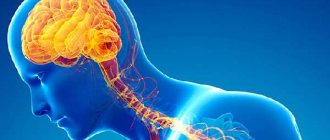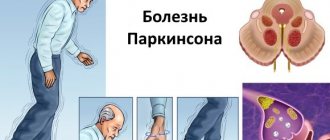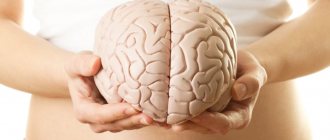Parkinson's disease is a disease that occurs due to the death of nerve cells. In this case, there is a deterioration and then a rupture of neuronal connections between different parts of the central nervous system. The imbalance that occurs in the synthesis and release of neurotransmitters leads to disturbances in thought processes and coordination of movements, and memory loss.
The disease is widespread throughout the world. Elderly people suffer from it more often, but the number of cases of early manifestation of the disease (up to 40 years) is growing every year.
Parkinson's disease is characterized by disturbances in balance and gait
The rate of progression of the pathology is individual for each patient. Each stage can last from several months to several years, and the latest treatments can help slow or even stop the process of neuronal destruction.
Development of the disease
Parkinson's pathogenesis develops over years. Neurons are being destroyed in the anterior sections of the substantia nigra. The first changes appear when 60-80% of nerve cells die in this zone.
| Stages of pathogenesis | Changes in functional anatomy and cell physiology |
| First phase | The cells of the anterior sections of the substantia nigra die, alpha-synuclein accumulates in the cytoplasm, microglia are activated, and astrocytes die. |
| Second phase | The functioning of neurons is disrupted. Therefore, the connection between neurons of the basal ganglia and peripheral cells suffers. Due to this, the normal functioning of agonist and antagonist muscles is disrupted. |
| Third phase | Degenerative changes lead to atrophic changes in the muscles, the formation of joint immobility, and problems with maintaining balance. These changes paralyze the patient. |
Parkinson's: causes
Medical research identifies several reasons for the onset of damage to dopamine cells in the brain:
- First of all, this is a hereditary predisposition. If older relatives have had this disease in their family, there is a possibility of inheriting it.
- Aging of the body, leading to the breakdown of certain cells, including those containing dopamine.
- The negative influence of toxins and poisons that affects brain cells or slows down their nutrition through the blood supply, leading to necrosis. These include bacterial damage, for example, encephalitis or tetanus. Microorganisms that provoke the disease release caustic toxins during their life processes, primarily poisoning brain cells.
- Often, brain tumors cause the destruction of healthy cells.
- Mechanical impacts, such as traumatic brain injury, can also cause the death of certain parts of the brain.
- Atherosclerosis of cerebral vessels not only increases the risk of stroke, but also interferes with the normal blood supply to its areas, leading to cell death.
- Drug addiction and other types of intoxication of the body, including ethanol, cyanide, and antipsychotic drugs significantly increase the risk of developing Parkinson's syndrome.
Hen-Yar classification
English doctors Margaret Hen and Melvin Yahr developed a classification of Parkinson's disease in the mid-20th century. It is still used in clinical practice today. After all, the stages are described in detail. They help the treating doctor navigate the prescription of therapy. In addition, the Hoehn-Yahr scale accurately describes the patient's signs of disability. This means that in the final stages a person needs help and cannot care for himself.
Important! The classification has been slightly modified. Later, stages 0, 1.5 and 2.5 were added to it.
Classification criteria
- Presence of symptoms of Parkinson's disease;
- Manifestation of the clinic on one side or both sides. Is the torso involved?
- Presence of postural instability;
- Ability to overcome inertia of movement;
- Self-care ability;
- Ability to stand and walk with assistance.
Quality of life cannot be assessed using the Hen-Yar classification. There is a Unified Rating Scale (UPDRS) for this purpose. It covers a wide range of criteria from sleep disorders to speech problems and depression. However, general practitioners and neurologists rarely use it. After all, such testing is labor-intensive and requires special training of a specialist.
Hen-Yar scale
| Stage | Manifestations |
| Zero | There is no clinic. At the same time, processes of neurodegeneration may already be actively occurring in the brain. |
| First | There is a clinic on one of the limbs. |
| Stage 1.5 | There are symptoms on the trunk and limbs. |
| Second | Bilateral body involvement. |
| Stage 2.5 | In addition to symmetrical symptoms, postural instability appears. But the ability to overcome the inertia of movement remains. |
| Third | Pronounced clinical picture of the disease. But the patient takes care of himself. |
| Fourth | Need help at home. The ability to walk and stand without support remains. |
| Fifth | Severe disability. Inability to walk or stand up. |
Diagnostics
Diagnosing Parkinson's disease is challenging. Indeed, despite common misconceptions, not a single neuroimaging study, except positron emission tomography, can reliably establish a diagnosis. Neither MRI of the brain, nor even ultrasound examination of the substantia nigra allows us to speak about the presence of the disease with a high degree of probability.
The only research method that allows us to talk about the presence of the disease is positron emission tomography (PET). When performing PET, there is a decrease in the accumulation of a special radioactive drug - fluodopa in the striatum and substantia nigra. Moreover, detection of the disease is possible even at the preclinical stage. However, the prevalence of the study is very limited, the study is extremely expensive at the present stage and in Russia it can only be carried out in large research src=»https://neurosys.ru/wp-content/uploads/posts/2014-02/1392397744_parkinsona-diagnostika. jpg" class="aligncenter" width="350″ height="324″[/img] As a rule, the diagnosis is made based on the clinical picture. In this case, the presence of characteristic symptoms, the typicality of the clinical picture and complaints, as well as the sequence of progression of symptoms must be taken into account. Also, a neurological examination reveals the presence of bradykinesia, the “cogwheel” phenomenon and other specific symptoms of the disease.
A good response to therapy with levodopa-containing drugs also plays an important role in diagnosis. Symptoms usually disappear completely or almost completely at the first appointment.
How does the disease manifest itself?
The early stages are the hardest to recognize. Clinic zero is not expressed. The development of neurodegeneration can only be indicated by diagnostic studies of the brain. And the first symptoms (tremor or spasm) are often mistaken for a variant of the “senile norm”. In any case, you need to be attentive to your loved ones and consult a doctor in a timely manner. The earlier treatment is started, the slower the disease progresses.
Zero stage
It is known that the first changes characteristic of Parkinson’s begin to occur in the patient’s brain at the age of 50-65. However, the patient has no idea about them. After all, the etiological factor of the disease has not been established. And the clinic appears when more than half of the neurons die. But if a person without symptoms has changes in the anterior part of the substantia nigra, then the likelihood of illness in the future is high. However, to set the zero stage, a more thorough and in-depth examination should be performed.
First stage
It also goes unnoticed. Patients with the trembling form develop tremors at this stage. In this case, the disease is easier to diagnose. Trembling occurs at rest and affects only one part of the body (head, finger, arm, hand, leg). Other clinical signs may occur.
- Decreased sense of smell;
- Depression and other mood disorders;
- Insomnia;
- Decreased resistance to physical activity;
- Problems with potency.
Stage 1.5
New symptoms progress slowly and unnoticeably. However, the patient may indicate the following manifestations of the disease:
- Tremor from one area spreads to the entire limb. For example, if a finger trembles, the tremor spreads to the hand or arm;
- Rigidity or stiffness of the muscles appears. Patients are especially concerned about the back and neck muscles;
- In women, the manifestations of the disease at this stage look like cervical osteochondrosis.
Stage 2
- Symmetrical lesion on both sides;
- Tremor of the lips, lower jaw, tongue, head;
- Increased salivation;
- Bradykinesia develops. Habitual actions take more time;
- Walking pace slows down;
- Amymia appears. The face stops displaying emotions;
- There are problems with sweating;
- The skin becomes dry. They require constant hydration.
Stage 2.5
At this stage, postural instability develops. This is the inability to maintain an upright body position in certain situations. The patient loses stability when walking with turns. During this period, it is still possible to independently overcome the inertia of rest or the inertia of movement.
Patients often develop an inability to begin walking or, once started, to recover in time. Sometimes the patient begins to move as if the torso is ahead of the legs. This often leads to loss of stability and falls.
Third stage
It is characterized by impaired postural stability and further progression of syndromes. The following clinical signs are available:
- Muscle stiffness;
- Spastic muscle tone;
- The “gear wheel” symptom is formed;
- "Doll walk" This clinical sign is characterized by small mincing steps;
- Clumsiness. Muscle spasm makes movements awkward and gait unsteady;
- Sudden loss of facial expressions;
- Petitioner pose;
- Muffled speech.
At the same time, you still have the opportunity to take care of yourself. Some patients even retain work skills if they do not involve physical labor.
The third stage is characterized by retropulsion. The doctor and assistant stand on either side of the patient. The doctor pushes the man in the chest. At the same time, he loses stability. Then the test is repeated with a push in the back.
Fourth stage
- Tremor progresses in this phase. He worries the patient constantly. It significantly disrupts his life and makes self-care difficult;
- The patient's quiet, nasal voice appears. The speech does not have a pronounced emotional coloring. The clarity of pronunciation of phrases is lost;
- Muscular rigidity significantly impairs patient care. Stiffness prevents you from performing your usual everyday activities;
- Difficulty getting out of bed on your own;
- When walking, falls often occur and cause serious injury.
Fifth stage
The terminal stage of the disease, in which the patient requires constant care.
- The patient does not move independently. In the early stages, movements are possible only within the bed;
- To move, a wheelchair is used or the patient moves with the support of relatives;
- Swallowing is impaired, making it difficult to eat independently;
- Disturbance in urination.
Acute decompensation
This is a reversible, serious condition that develops in patients with Parkinson's disease. Causes of acute decompensation:
- Complication of dopaminergic therapy;
- Exacerbation of somatic pathology;
- Injuries;
- Psychogenic disorders.
Clinical picture of decompensation:
- Development of dyskinesias;
- Increased tremor, despite adequate therapy;
- Lack of effect from taking levadopa;
- Increased body temperature (without pronounced inflammatory changes in the main organs and tissues);
- Severe muscle rigidity with complete impairment of mobility;
- Loss of speech;
- Impaired consciousness up to stupor and coma.
With such clinical manifestations, the patient should be urgently hospitalized in the intensive care unit. Against the background of decompensation, breathing and swallowing disorders rapidly progress.
Non-motor symptoms
In addition to the motor symptoms of the disease, non-motor symptoms are often encountered:
- in the autonomic sphere: orthostatic hypotension, postprandial hypotension, hypertension in the supine position, fixed pulse, urinary urgency, frequent urination, urinary incontinence, nocturia (running to the toilet at night, difficulty urinating, weak stream of urine, intermittent urination, feeling of incomplete emptying of the bladder, salivation, constipation, bloating, delayed gastric emptying, impaired sweating: either heavy or weak sweating, impaired thermoregulation, seborrhea - increased greasiness of the skin, increased secretion of earwax, erectile dysfunction in men, anorgasmia, disorder lubrication in women, marbling and thinning of the skin);
- in the cognitive sphere: almost all patients develop problems with memory, attention, thinking, against this background visual hallucinations, hallucinations of other modalities, delusions are not uncommon - i.e. loss of connection with reality;
- rarely do any patients notice a decrease in the sense of smell or color and twilight vision;
- The phenomenon of chronic fatigue is quite common;
- sleep and wakefulness disorders;
- very common symptoms are anxiety and depression, less often anhedonia, i.e. loss of the sense of pleasure, apathy, i.e. a categorical lack of desire for any activity; in relatively young patients, various manias occur: shopping mania: passion for shopping, gambling addiction – passion for gambling, etc.;
- pain of various types, usually mild, aching, often in the muscles of the shoulder girdle.
Non-motor symptoms become significant in advanced and late stages of the disease.
But in the first place, among the maladaptive signs of the disease, are, of course, movement disorders.
Hypokinesia is the main symptom of parkinsonism, observed in all patients, without which diagnosis becomes impossible; this most disabling phenomenon consists of two components: bradykinesia (slowness of movements) and oligokinesia - impoverishment of the motor pattern. Patients cannot develop voluntary movement sufficient in speed and amplitude (hypometry), which sometimes becomes fragmentary. Fine motor skills suffer, handwriting becomes small, especially towards the end of a sentence, difficulties arise in putting a hand into a sleeve of clothing, facial expressions become poorer, the frequency of blinks becomes more frequent, the friendly movement of the arms when walking is lost, the step shortens, the gait becomes mincing, the step “sliding”, etc. Speech disturbances appear: dysprosody: monotony, loss of melody of speech, hypophonia (quiet voice), bradyllia (slowing of speech due to difficulty in making distinct sounds), nasophonia: speech has a slightly nasal (nasal) tone
Rest tremor may not develop at all in Parkinson's disease, to the surprise of most people. The resting tremor resembles the movements of the fingers when rolling pills or while counting coins. It begins with the distal parts of the upper extremities, then the legs, lower jaw, and chin are involved in the pathological process. It is important to emphasize that Parkinson's disease never begins with a head tremor.
Rigidity is manifested by plastic muscle hypertonicity, when the researcher, during repeated passive flexion and extension of the limbs or neck, feels increasing involuntary muscle tension, which intensifies with repeated movements.
In advanced stages of Parkinson's disease, postural instability occurs. Patients can walk independently, but if they are thrown out of balance, they cannot stop, so the involuntary forward movement is called propulsion; if the patient does not rest against something solid, he will fall. The backward movement is called retropulsion, as a rule, doctors use Thevenard’s technique, standing behind the patient’s back and pushing him back by the shoulders; if the patient resists, then the stage of the disease is no higher than the second. At the final stages, patients are not even able to sit independently; when they fall, the phenomenon of postural instability is called lateropulsion. Regarding other postural disorders: even with minimal symptoms in the initial stages, if you ask the patient to stretch his arms forward, you will notice that the more affected arm is slightly bent at the elbow joint. Classic postural disorders are clearly visible in patients in a standing position: the head is slightly lowered, the arms are pressed to the body, half-bent at the elbow joints, the forearms are somewhat turned outward, the posture is “bent”, in extreme cases the torso is parallel to the floor (in the supine position the torso is straightened), the legs are also half-bent at the hip and knee joints, located parallel to each other; this body position is called the “supplicant pose.” In some cases, persistent articular deformities of the hands and feet develop, which also refers to postural disorders.
Depending on the predominance of a particular syndrome in the clinical picture of the disease, neurologists distinguish akinetic-rigid, tremulous, trembling-rigid, rigid-trembling (the last two are easier to combine into one group - mixed) clinical forms of Parkinson's disease.
Features of the course of the disease in different groups
| Average age of onset of symptoms after 60 years | Average age of onset of symptoms after 45 years | |
| Duration of illness | About 10 years | More than 15 years |
| Severity of clinical symptoms | Rapid progression, large number of patients with stages above 2.5 | Slow course of the disease with adequate therapy, a large number of patients with mild stages |
| Levadopa dosage | Large doses are required to correct the disorder | Levadopa is not prescribed for initial therapy, only in severe cases |
| Side effects from treatment | Often expressed | Occurs in the treatment of resistant forms |
| Severity of motor and psychoemotional disorders | Movement disorders are more pronounced in this group; decompensations occur, requiring psychiatric help. | Emotional disturbances are expressed, the help of a psychotherapist is required |
Course of Parkinson's disease: men and women
| Men | Women |
| Frequency of occurrence | Get sick 2 times more often |
| Mortality rate | Women have higher |
| Progression of symptoms | Progresses faster |
| Difference in clinical signs: | |
| "Begging Pose" | More often in men |
| Depression | More often in women |
| Cognitive decline | More often in men |
| Depression, anxiety | More often in women |
Description
Parkinson's disease is a chronic pathology with slow progression.
With it, there is a gradual death and death of neurons that produce the neurotransmitter dopamine. The lack of this substance leads to a disruption in the functioning of the cerebral cortex, which is why the symptoms of the pathology arise. The disease remains incurable, and therapy is carried out only to alleviate the patient’s condition. Also, proper treatment helps reduce the rate of progression of the disease, which is especially important when it is detected in youth.
In men, the disease occurs somewhat more often than in women, and occurs in a more severe form.
A person's nationality does not change the likelihood of developing the disease.
Parkinson's disease in women
The peculiarity of the pathology in women is due to the fact that estrogens take an active part in the production of the neurotransmitter dopamine.
This property reduces the risk of Parkinson's disease in women if they do not experience hormonal imbalances. This same feature also leads to the fact that among women the number of patients increases sharply in the period after menopause, when estrogen levels drop. For the occurrence of the disease, an early onset of menopause is considered a particularly favorable factor, which indicates hormonal weakness. The risk of getting the disease is slightly higher in women who have had 3 or more pregnancies, as this condition affects hormonal levels.
A particular risk of developing the disease is the removal of the ovaries or serious impairment of their function due to diseases, due to which the level of estrogen in the body falls catastrophically.
Parkinson's disease in men
No specific features of the pathology were identified in men.
Male hormones also influence the formation of pathology and the degree of its development. The only difference from the female form of the disease is that Parkinson's disease is more common in the stronger sex and begins at an earlier age. Symptoms are the same for both sexes.
Parkinson's disease in older people
The disease appears due to age-related changes against the background of the natural aging process in brain tissue.
This phenomenon is usually preceded by injury, infectious brain damage or stroke. The disorder is accompanied by other symptoms of brain tissue destruction in the elderly.
Parkinson's disease in young people
Cases of the onset of Parkinson's disease in young people, in the age group from 20 to 40 years, are not frequent.
They account for about 10% of the total number of cases. The disease progresses noticeably more slowly than in old age, and its symptoms are somewhat blurred and not very bright. In most patients, at the beginning of the development of pathology, only minor pain is observed during muscle contractions in the extremities. This symptom is quite similar to how arthritis manifests itself, which complicates diagnosis. Later, involuntary muscle contractions may occur in the limbs or body, which cause noticeable pain. As the disease develops, characteristic symptoms of its clinical course become noticeable, characteristic of patients of any age. From now on, making the correct diagnosis is no longer difficult. Therapy, as in elderly patients, is only supportive.
Modern and innovative approaches to the treatment of Parkinson's disease
Life expectancy by stage
| Stage | Lifespan | What to do to prolong life? |
| First stage | Symptoms are minimal, so life expectancy is difficult to predict. It will be equal to a healthy person from the population. Without treatment, the transition to progression occurs after 3 years. | Early diagnosis and treatment of the disease, giving up bad habits and following a sleep and rest schedule will allow you to stay in the first stage longer. |
| Second stage | Symptoms are progressive. This is the time for clinical diagnosis and initiation of therapy. Without it, the patient will progress to loss of self-care after 3 years. With adequate therapy, symptoms progress slowly. The patient may linger at this stage for a decade. | Control of therapy, competent selection of drugs, treatment of concomitant diseases, maintaining a healthy lifestyle |
| Third stage | Requires assistance from an outsider to perform complex actions. He copes with everyday tasks independently, but there are limitations. Progression over 15 years with adequate therapy and constant care. | Compliance with doctor’s recommendations, selection of medication dosage, regular social activity, monitoring of somatic pathology. |
| Fourth stage | Irreversible changes lead the patient to complete dependence on outside help. With proper care, the stage lasts 2-5 years. | Patient care, drug control. |
| Fifth stage | On average it lasts about a year. | Care, prevention of bedsores and congestive pneumonia |
The course and prognosis of Parkinson's disease and parkinsonism.
The disease is steadily progressing. The exception is some forms caused by drug intoxication (if the drugs are discontinued, the condition may improve). It is generally accepted that treatment at the initial stage can reduce the severity of symptoms and slow down the progression of the disease. In later stages, treatment measures are less effective. The disease leads to disability for several years. Even treatment with levodopa currently slows the progression for a short period of time. This confirms the position that the basis of the disease is not only a primary biochemical defect, but also an as yet unstudied neuropathological process.
Therapeutic approaches at different stages
| Early stages From 0 to 2.5 | Late stages 3 to 5 | |
| Approach to therapy for young people | Monotherapy (amantadines, anticholinergics, dopamine receptor agonists (DRA)) | Combination therapy (levadopa + amantadines, anticholinergics, ADR) |
| Therapy for the Elderly | Minimum effective doses of levadopa (amantadines, anticholinergics with caution) | Levadopa + dyskinesia correctors (clonazepam, muscle relaxants) + therapy for mental disorders (olanzapine) + combating orthostatic hypotension (midodrine, glucocorticosteroids) |
| Diet | Balanced diet, no alcohol, moderate protein intake | Low Protein Diet |
| Non-drug methods | Exercise therapy complex daily, sports, dancing, oriental gymnastics | Exercise therapy, application of biological feedback methods using a stabilogram |
| Surgery | Used in young patients. Functional neurosurgery methods are used: stereotactic destruction of individual zones, deep brain stimulation. At the development stage, intracerebral implantation of embryonic dopamine-producing stem cells. |
Patient care
At the fourth and fifth stages, the patient loses the ability to care for himself. He requires daily care and help at home. It can be provided by relatives or a caregiver.
- Prevention of bedsores. For this, positioning or a special anti-decubitus system is used. In the first case, the patient needs to be turned frequently, ensuring a comfortable position. In the second case, an automatic mattress is used, which deflates and inflates independently. Hygiene procedures are carried out daily, the skin is moisturized with cream. A medicinal ointment is applied to diaper rash and maceration;
- Breathing exercises. Carried out to prevent congestive pneumonia;
- Stimulation of independent activity (minimum maintenance while maintaining skills);
- Daily exercise therapy complex (in active and passive mode);
- Monitoring medication intake (for older people, transdermal options, a patch on the skin may be suitable);
- Psychological support (joint conversation, talking about new events, memories, viewing photos and videos).
Parkinson's disease is a progressive disease. It inevitably moves from stage to stage. And medicine cannot prevent it. However, it takes courage and patience to slow down the progression of the disease.







![Eating Well for Parkinson's Disease [2020 Guide]](https://3d-panneco.ru/wp-content/uploads/pravilnoe-pitanie-pri-bolezni-parkinsona-rukovodstvo-2020-330x140.jpg)



